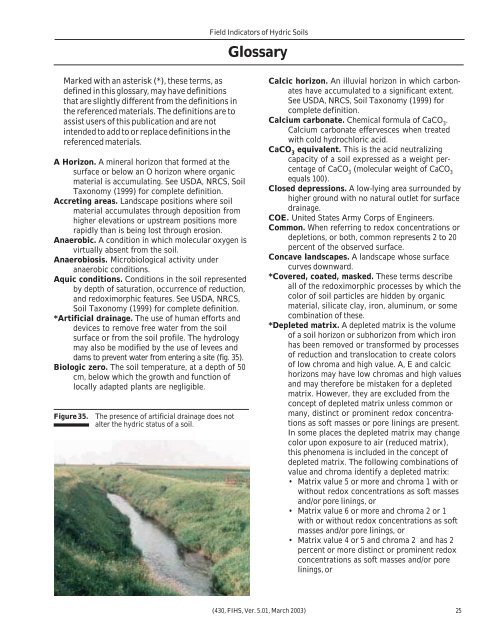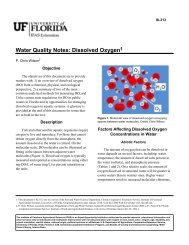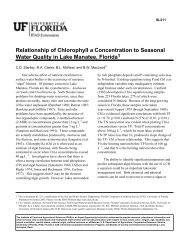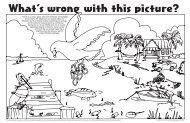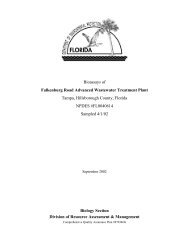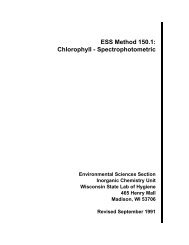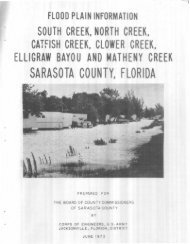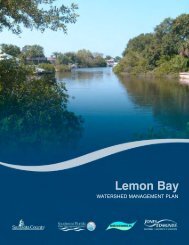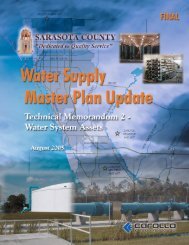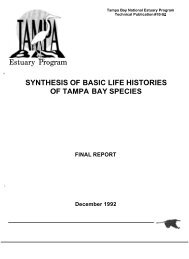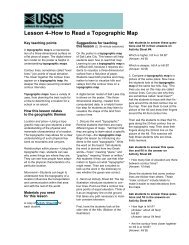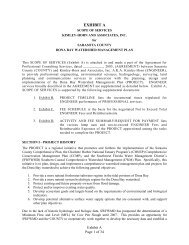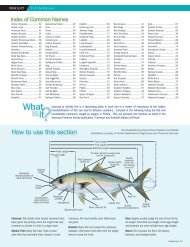Field Indicators of Hydric Soils in the United States - ITC
Field Indicators of Hydric Soils in the United States - ITC
Field Indicators of Hydric Soils in the United States - ITC
Create successful ePaper yourself
Turn your PDF publications into a flip-book with our unique Google optimized e-Paper software.
<strong>Field</strong> <strong>Indicators</strong> <strong>of</strong> <strong>Hydric</strong> <strong>Soils</strong>GlossaryMarked with an asterisk (*), <strong>the</strong>se terms, asdef<strong>in</strong>ed <strong>in</strong> this glossary, may have def<strong>in</strong>itionsthat are slightly different from <strong>the</strong> def<strong>in</strong>itions <strong>in</strong><strong>the</strong> referenced materials. The def<strong>in</strong>itions are toassist users <strong>of</strong> this publication and are not<strong>in</strong>tended to add to or replace def<strong>in</strong>itions <strong>in</strong> <strong>the</strong>referenced materials.A Horizon. A m<strong>in</strong>eral horizon that formed at <strong>the</strong>surface or below an O horizon where organicmaterial is accumulat<strong>in</strong>g. See USDA, NRCS, SoilTaxonomy (1999) for complete def<strong>in</strong>ition.Accret<strong>in</strong>g areas. Landscape positions where soilmaterial accumulates through deposition fromhigher elevations or upstream positions morerapidly than is be<strong>in</strong>g lost through erosion.Anaerobic. A condition <strong>in</strong> which molecular oxygen isvirtually absent from <strong>the</strong> soil.Anaerobiosis. Microbiological activity underanaerobic conditions.Aquic conditions. Conditions <strong>in</strong> <strong>the</strong> soil representedby depth <strong>of</strong> saturation, occurrence <strong>of</strong> reduction,and redoximorphic features. See USDA, NRCS,Soil Taxonomy (1999) for complete def<strong>in</strong>ition.*Artificial dra<strong>in</strong>age. The use <strong>of</strong> human efforts anddevices to remove free water from <strong>the</strong> soilsurface or from <strong>the</strong> soil pr<strong>of</strong>ile. The hydrologymay also be modified by <strong>the</strong> use <strong>of</strong> levees anddams to prevent water from enter<strong>in</strong>g a site (fig. 35).Biologic zero. The soil temperature, at a depth <strong>of</strong> 50cm, below which <strong>the</strong> growth and function <strong>of</strong>locally adapted plants are negligible.Figure 35. The presence <strong>of</strong> artificial dra<strong>in</strong>age does notalter <strong>the</strong> hydric status <strong>of</strong> a soil.Calcic horizon. An illuvial horizon <strong>in</strong> which carbonateshave accumulated to a significant extent.See USDA, NRCS, Soil Taxonomy (1999) forcomplete def<strong>in</strong>ition.Calcium carbonate. Chemical formula <strong>of</strong> CaCO 3.Calcium carbonate effervesces when treatedwith cold hydrochloric acid.CaCO 3equivalent. This is <strong>the</strong> acid neutraliz<strong>in</strong>gcapacity <strong>of</strong> a soil expressed as a weight percentage<strong>of</strong> CaCO 3(molecular weight <strong>of</strong> CaCO 3equals 100).Closed depressions. A low-ly<strong>in</strong>g area surrounded byhigher ground with no natural outlet for surfacedra<strong>in</strong>age.COE. <strong>United</strong> <strong>States</strong> Army Corps <strong>of</strong> Eng<strong>in</strong>eers.Common. When referr<strong>in</strong>g to redox concentrations ordepletions, or both, common represents 2 to 20percent <strong>of</strong> <strong>the</strong> observed surface.Concave landscapes. A landscape whose surfacecurves downward.*Covered, coated, masked. These terms describeall <strong>of</strong> <strong>the</strong> redoximorphic processes by which <strong>the</strong>color <strong>of</strong> soil particles are hidden by organicmaterial, silicate clay, iron, alum<strong>in</strong>um, or somecomb<strong>in</strong>ation <strong>of</strong> <strong>the</strong>se.*Depleted matrix. A depleted matrix is <strong>the</strong> volume<strong>of</strong> a soil horizon or subhorizon from which ironhas been removed or transformed by processes<strong>of</strong> reduction and translocation to create colors<strong>of</strong> low chroma and high value. A, E and calcichorizons may have low chromas and high valuesand may <strong>the</strong>refore be mistaken for a depletedmatrix. However, <strong>the</strong>y are excluded from <strong>the</strong>concept <strong>of</strong> depleted matrix unless common ormany, dist<strong>in</strong>ct or prom<strong>in</strong>ent redox concentrationsas s<strong>of</strong>t masses or pore l<strong>in</strong><strong>in</strong>gs are present.In some places <strong>the</strong> depleted matrix may changecolor upon exposure to air (reduced matrix),this phenomena is <strong>in</strong>cluded <strong>in</strong> <strong>the</strong> concept <strong>of</strong>depleted matrix. The follow<strong>in</strong>g comb<strong>in</strong>ations <strong>of</strong>value and chroma identify a depleted matrix:• Matrix value 5 or more and chroma 1 with orwithout redox concentrations as s<strong>of</strong>t massesand/or pore l<strong>in</strong><strong>in</strong>gs, or• Matrix value 6 or more and chroma 2 or 1with or without redox concentrations as s<strong>of</strong>tmasses and/or pore l<strong>in</strong><strong>in</strong>gs, or• Matrix value 4 or 5 and chroma 2 and has 2percent or more dist<strong>in</strong>ct or prom<strong>in</strong>ent redoxconcentrations as s<strong>of</strong>t masses and/or porel<strong>in</strong><strong>in</strong>gs, or(430, FIHS, Ver. 5.01, March 2003) 25


